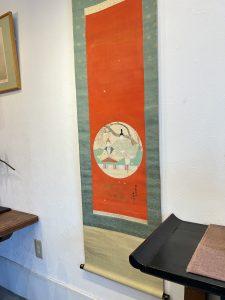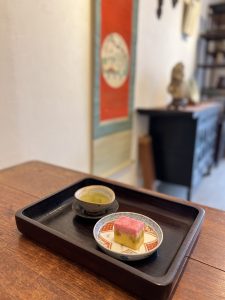自分の中の春の風物詩がよみがえってきました。(愛知県名古屋市千種区姫池通 骨董買取 古美術風光舎)
2024.02.15
みなさまこんにちは、スタッフYでございます。
ここ名古屋、2月にしては少し不気味な暖かさでして。戸惑っている方もおいでではないでしょうか。今朝も通勤の車から皆さま何を着ているのか見ておりましたが、ダウンコートやウールのコートなど着ている方はいませんでした。困りましたね。春の「何着ていいか問題」が、頭をよぎりました。これも自分の中の春の風物詩であります。

ところで先日、雛飾りのお殿様の烏帽子の羽みたいなことろの付け根の部分がとれてしまい…と、いうつぶやきをいたしまして、「あの羽の部分は何というのか教えてください。」というつぶやきにご親切にもお返事をいただきました。
正式にはあの羽の分は「纓」(えい)というとのことでした。
この漢字も初めて知りました。「櫻」という字に似ておりますがちょっと違います。結構長く生きておりますが、知らない言葉はまだまだあるようでして、「へぇーーっ」と、いう顔をした人も私の他にもいらっしゃるかもしれませんね。
その「纓」(えい)ですが、少し調べてみましたが、冠の付属具で背後の中央に垂らす部分のことをいいます。
古くは、髻 (もとどり) を入れて巾子 (こじ) の根を引き締めたひもの余りを後ろに垂らしたとのことですが、後には幅広く長い形に作って巾子の背面の纓壺 (えつぼ) に差し込んでつけたようでいして、我が家のお殿様もこの造りのようでした。時代により形状が異なり、垂纓 (すいえい) ・巻纓 (けんえい) ・立纓 (りゅうえい) ・細纓 (さいえい) ・縄纓 (なわえい) などの区別があり、今回の大河ドラマも殿方がこのような装束で登場いたしますので楽しみにチェックしてみたいと思っております。
それにしても、こうやって無知なことを恐れず助けを求めておりますと親切な方がいらっしゃることにも気付きます。教えてくださり誠にありがとうございました。
そんな春の追っかけの最中で、先日の梅ではないですが花を愛でていますとどこかしら団子(菓子)も気になってくるのも自分の中の春の風物詩でして…。ご近所の和菓子店を覗いてみました。
思った通り和菓子も春らしい色鮮やかなものがケースの中に並んでおり、お雛様のひしもちをイメージしたような和菓子をついつい購入。

よって、本日のおやつは和菓子となりましたので、花より団子(菓子)、一足お先に失礼いたします。
それではごきげんよう。
Hello everyone, this is Staff Y.
It’s been a little bit eerily warm for February here in Nagoya. Some of you may be a bit puzzled. This morning, I was looking at what everyone was wearing from my car on my way to work, and I didn’t see anyone wearing down coats or wool coats. I was puzzled. The spring “what to wear problem” came to mind. This is another spring tradition in my mind.
By the way, the other day, I tweeted that the base of the feather-like part of the hat of the lord of Hina decorations had fallen off… Please tell me what that feather-like part is called. Please tell me what that feather part is called.
Officially, I was told that the part of the feather is called “ei” (纓).
I had never heard of this kanji before. It looks like the character for “cherry blossom,” but it is a little different. I have been alive for quite a long time, but it seems that there are still many words that I do not know.
I looked up the word “ei,” and found that it is an accessory of the crown that hangs down in the center behind the crown.
In the old days, the tail was made by putting a knot in the hair and tightening the root of the coiled hair, and hanging the remainder of the string from the back of the coiled hair. The shape of the tail varies depending on the period, and there are different types of tail such as a hanging tail, a rolled tail, a standing tail, a thin tail, and a rope tail.
I am looking forward to checking them out. Thank you very much for teaching me.
In my pursuit of spring, I also find myself interested in dumplings (sweets) when I admire flowers, not the plum blossoms I saw the other day, so I took a look at a nearby Japanese sweets store.
As I expected, there were brightly colored spring-like wagashi lined up in the case, and I couldn’t resist buying some. I guess these wagashi are inspired by hishimochi (rice cakes) for hina dolls.
Therefore, today’s snack was a wagashi. Please excuse the dango (confectionery) before the flowers.
Have a good day.

